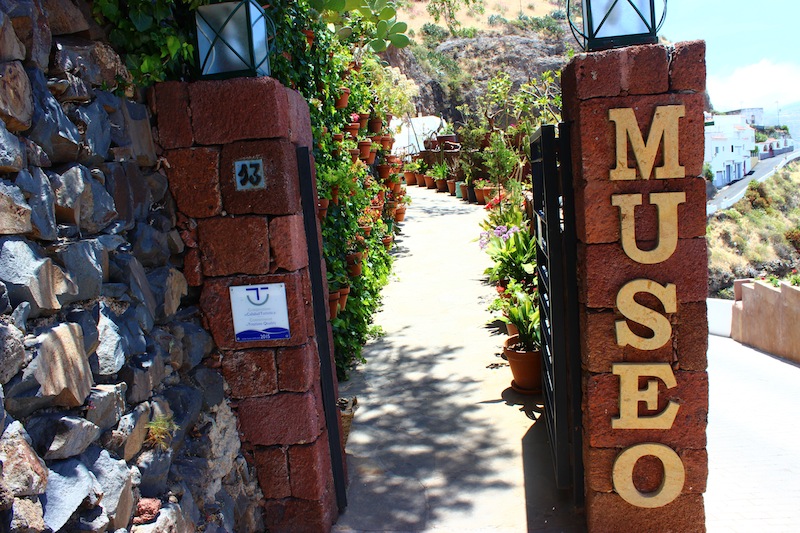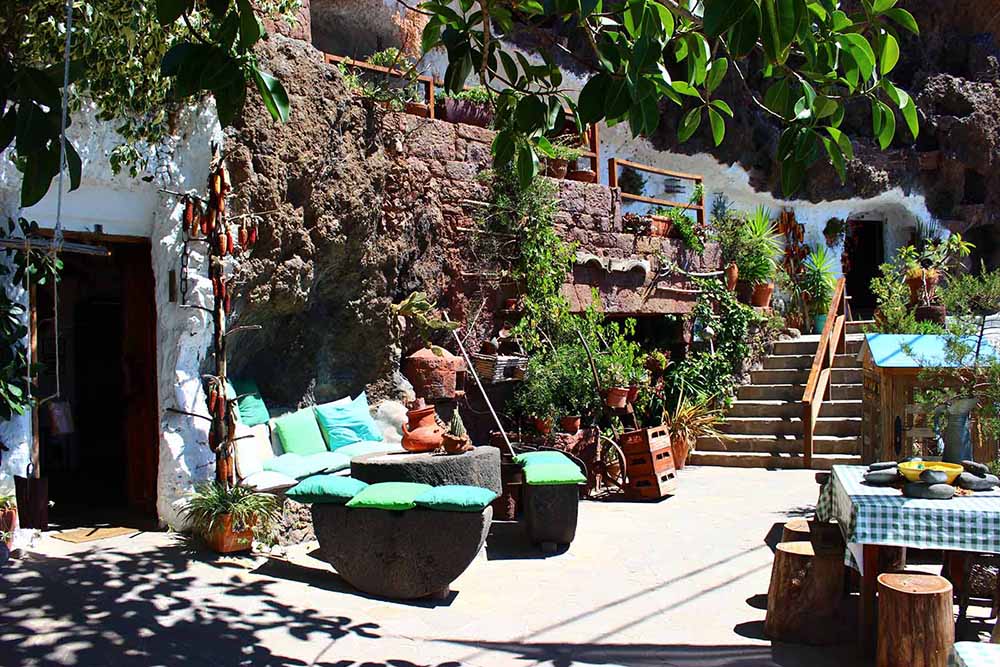Welcome to the Museum of Cave Houses, in Artenara
The cave dwellings of Artenara were very important in the development of this area. The original inhabitants were from North Africa, a tribe of Berbers called the Canari. There is recorded evidence that the cave houses of the nearby village of Acusa were occupied continually from approx. 500AD to the 1970´s. So for about 1000 years before the Spanish conquest there were settlements in thhis area. The original inhabitants made the very intelligent dicision that farming land was too important to waste on housing, so they decided to make use of the natural rocks in the area to excavate cave houses and shelters. This is one of the reasons for the uique development of this area.
Weolcome to he beauty of a simple life! We invite you to enjoy your visit to our "Museum of Cave Houses" in Artenara near to the summit of Gran Canaria. It also shows taht it is possible to live a good simple life without so many "trappings of modern life", which are often superfluous.

The Entrance Patio
Traditionally life in the courtyard of the caves, took place mainly in the evenings before dusk. The courtyard was used for many everyday chores, cooking, laundry, shelling almonds, drying figs, cleaning potatoes, toasting maize, and espcially to "talk".

Cave No. 1 The Simple Life
In Cave No.1 we are trying to show the lifestyle of a working family without too any economic resources.
In its three rooms you can see the iron beds which are raised to avoid humidity. In the centre of the living room there is a simple "tallero" (Stone Water Filter) that comes from Las Canteras, a district of Las Palmas. There are also canary style stools, some pottery, a prayer table, some tea chests and a large table "tocinera". Mats woven from palm leaves also helped protect against the dampness from the earth floors.

Cave No. 2 Agriculture and its tools
Cave No. 2 we have devoted to agriculture.
As you enter the cave you can see hanging from the ceiling some red corn cobs drying, there are used for making gofio. To the left there is a machine that separates the grains of maize from the corn cob, work that was once done by hand. To the right we see a "Talla", a tool for the pressing of bitter almonds, this made an oil which is famous for its use in cosmetics and medicine. This local oil of biter almonds is difficult to obtain an d the cost is high, because you need four kilos of almonds to make one litre of oil. On the inside of this cave is the family "bodega" (wine cellar), on the left there is a small bath locally known a a "goro", notice the ropes to aid balance whilst treading the grapes with bare feet. The baskets and drying raks are made from canes, from nearby Chajunco, these were used both to dry the cheeses, and for drying the figs and the tunos (the cactus fruit).

Cave No. 3
Cave No. 3 is almost entirety natural basalt (this is a "living stone" and is difficult to excavate). In this cave you have a natural well, and a small garden, in which the sound of the water in the sink might encourange you to join in the songs and laughter of the ladies washing clothes. Red hands in the winter, smells of clean clothes in the sun...
Cave No. 4 is dedicated to trades and crafts.
Cave No. 4 is designed to show the most relevant trades and crafts in Artenara in years gone by. In the first palce the miners, without them there would be no Artenara, their old tools are showun here in with the heavy rubble. The wooden looms made possible the conversion of the wool from the livestok into blankets, fabrics, cloth, etc.
The potters of Lugarejos, Artenara, are very much appreciated for keeping alive a tradition, which comes from our ancestors, the Canarians of Pre-Hispanic times. The materials, and methods of making the pottery of Lugarejos are exhibited here.

Cave No. 5 An improved life style
Cave No, 5 we can see, by the quality of its furniture, would be inhabited by a wealthy family. This cave is a tribute to those of our ancestors that in times of great hunger, such as the early 20th century had to go to Cuba and South America to cut sugar cane; those who were able to return with silver (from the Indians), proudly displayed cloks and modern furniture from that time.
This cave has more spacious proportions, and better quality furniture. It has greater structural strength, this is achieved by a stone pillar that separates the bedrooms from the main room. We can observe that both this pillar and the wall on the right, are made with red stone blocks.

Cave No. 6
Once there were no toilets as we know them, there was an old expression:
¡ Váyanse pa´las tuneras ! "Go pee in the cactus plants!
Cave No. 7 is dedicated to the kitchen
In this Cave no. 7, we have tried to recreate what is most representative of a tradictional Artenara kitchen. At the entrance there are usually 4 large stones, a fire was made between them, and the cooking was done on this fire. There are some of the original cooking pots displayed here.
Before entering the cave on our left, there is a traditional oven used to bake bread. On the work surface of the kirchen to the right, we can see how to make gofio (the staple food of the Canarian people). The cheese in this area has been traditionally made from the milk of both goats and sheep, as olive oil still si today. The large pottery jar was used to preserve pieces of mear (pork or goat) in olive oil that was brought from San Bartolomé. Meat was also preserved in brine in stone carved basins using salt, this was obtained from the salt flats near Agaete. Various old kitchen utensils are siplayed in this cave.

Your tour has ended, Artenara invites you to sit the courtyard of the Museum cave houses to enjoy the silence and the singing of the birds. Enjoy the majestic landscape of the great tejeda barranco and think of the peace and simplicity of times gone by.
Here you can forget about time. Be Happy


